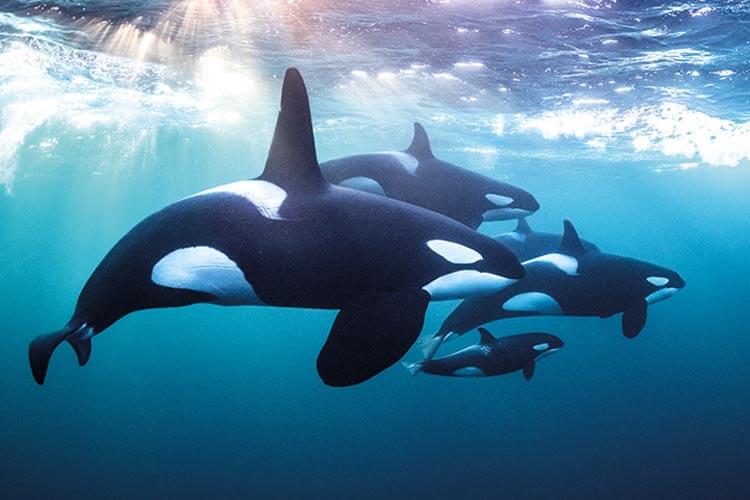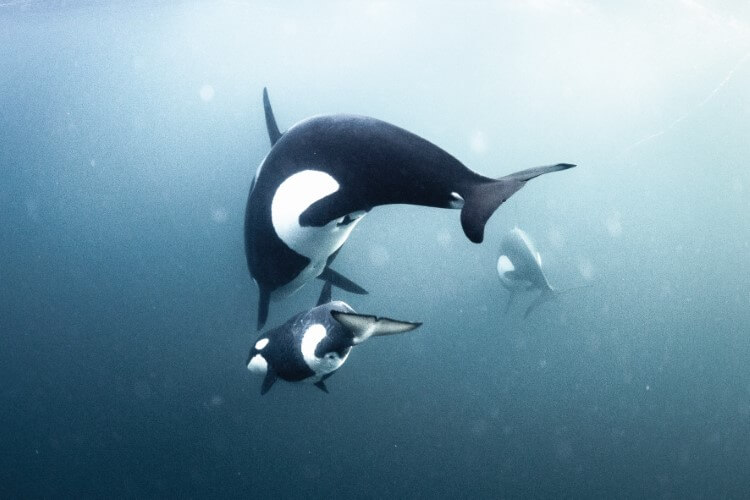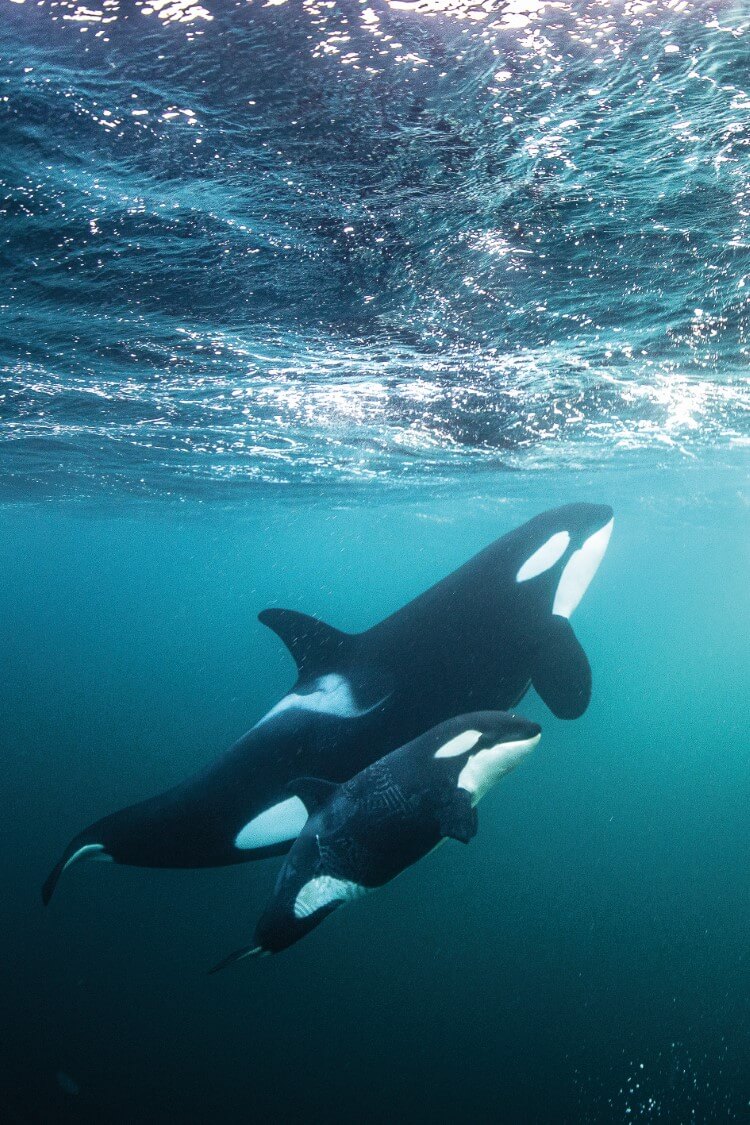
Expedition guide and underwater photographer, Todd Thimios, fulfils his childhood dream of swimming with orcas, capturing his experience with stunning images
Words and pictures By Todd Thimios
When I was a teenager, I watched a documentary called Killer Whales: Wolves of the Sea, which portrayed the incredible sight of orcas deliberately beaching themselves high on the sand to hunt young seals.
My mind was blown at the behaviour, which struck me as being performed in the name of fun, rather than the necessity of predation. That documentary was the beginning of an appreciation of these apex ocean predators that would grow into an overwhelming desire to connect with them underwater, and which would ultimately fuel my adventures and career for many years to come.
Fast-forward 15 years and I found myself filming this incredible and unique hunting technique on the very same beach in Patagonia, Argentina, where the original documentary had been filmed. I had been flown there by a wealthy, superyacht-owning businessman who wanted me to report from the location before deciding whether to visit himself. I could not believe what I was seeing.


The orcas’ attacks were clearly premeditated; a calculated evaluation between risk and reward as they beached. When I showed my employer the video and excitedly regaled him with my account of the experience, he was uninterested, but my appetite for future expeditions in search of close encounters with orcas had grown.
By the time I was 30, I had established a livelihood from doing something I truly loved. Underwater photography has been not only my greatest passion, but it also provided a viable way to travel the world.
As an expedition guide for superyacht owners, I experienced many incredible underwater adventures, from piloting a submersible to the 1,000-metre deep ocean floor, to a vast array of encounters while filming and leading dives. If there was one experience that was to top my bucket list of encounters, however, it was to go diving with orcas.
In 2015 I spent every cent I had on a mission to dive with orcas in the Arctic – and I didn’t see a single fin. Even though the timing of my visit was right, I quickly learned that there are many factors which need to align before the orcas appear. I would go on to return to the north of Norway for five consecutive seasons before everything started to click.


The main source of food for the resident population of orcas in Norway’s Arctic north is Norwegian spring-spawning herring, which gather in vast numbers each year off the coast of Norway during February and March. At one time severely depleted by industrial fishing, the herring stock has returned to sustainable levels, thanks to tightly-managed fisheries, and stands as a crucial element within the Arctic ecosystem.
Later in the year, orcas follow the mature herring as they migrate through Norway’s fjords, separating smaller groups of herring from the larger shoals and forcing them to the surface where, trapped between the surface and a curtain of bubbles exhaled by the orcas, they become easy prey.
Although the surrounding landscape is of a stunning and almost fairytale-like beauty, diving in northern Norway is harsh and demanding. Due to the sporadic and fast-paced nature of herring and orca encounters, freediving has always provided a more agile and successful approach than scuba diving for filming, so extra-thick wetsuits and an ample supply of weights are the order of the day.
Water temperature averages around five degrees Celsius, but it’s the wind-chill that really stings, driving the temperatures well below zero. Overnight snowfalls were at times so heavy that it would take hours to shovel the snow from our dive boat before we would be able to leave port, not forgetting that much of this happens in darkness, as northern Norway’s Arctic sun rises late in November. ‘Freezing’ and ‘dark’ are not the most ideal conditions for an underwater photographer.


It was on the last day of my fifth visit to Norway when the orca encounter I’d always dreamed of finally happened. Freezing, gale-force Arctic winds drove rolling, breaking swells across the open ocean; the temperature plummeted to minus-15 degrees, cutting through my 9mm hooded wetsuit and into my body. This was the last day before the sun would set, not to rise again until February, more than two months away.
In the final moments of that last day, we spotted a pod of orcas – but they were not where we had expected them to be. They were travelling together in rough, open ocean, rather than hunting along the sheltered coastline for migrating herring. They appeared to be playfully riding the ocean swells, their huge dorsal fins towering more than a metre above the surface.
Once I was certain that the pod was comfortable with our presence, I dropped about 200 metres in front of the travelling orcas. Should they choose to investigate, I would have only seconds to frame the shot as they passed. There was no room for error.
As luck would have it, they came incredibly close, effortlessly riding the swell to pass within metres of me. I was struck by the formation, and role of each member of the pod. The large, male bulls worked the perimeter of the pod, investigating their surroundings and protecting the matriarchal females sheltering the young.

Their curiosity, intelligence and power, combined with the last rays of Arctic light filtering through the rough ocean surface, created one of the most unforgettable moments of my life. When, exhausted, I climbed back onto the boat, I collapsed on the deck in disbelief at what I had just witnessed.
It was a brief encounter, but as I edited my photographs, back at home – and a world away – in the tropics of northern Queensland, Australia, I saw that I had captured it magnificently, with incredible Arctic lighting and the pod in perfect formation.
One afternoon, I uploaded a few images to my Instagram account and they were quickly picked up and reposted by hundreds of others. One woman, a total stranger to me, saw one of my pictures and loved it so much she wrote to me – and the rest became history. We are now married and the same photograph hangs above the cot of our daughter, Piper Pearl.
The teenage me watching that orca documentary never could have imagined the events it would put in motion, nor that it would ultimately lead to the pinnacle of my career – and the pinnacle of my personal life, my wife and daughter.
I hope my daughter joins me in the water, one day.
You can find more from Todd Thimios and his expert photography on his website at www.thimios.com, and on Instagram @toddthimios
More great reads from DIVE Magazine
- Accused: a dive instructor’s wrongful prosecution for manslaughter
- The mutual benefits of ocean cleaning stations
- Going Beyond: Alfred Minnaar learns to cave dive
- Underwater photographer Valentina Cucchiara: doing it with passion
- Fuvahmulah: the next great shark-diving destination



